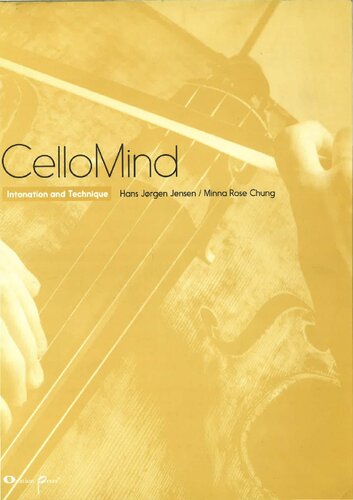Description
CelloMind – Intonation and Technique
CelloMind is a two-part pedagogical method book that focuses on intonation and left-hand cello technique. The co-authors of the book are Hans Jørgen Jensen, Professor of Cello at the Bienen School of Music at Northwestern University and Minnna Rose Chung, Associate Professor of Cello at the Desautels Faculty of Music at the University of Manitoba.
Intonation in Cello is an ebook about the skills that relate to music tunes and how to get the pitch harmonies in them. Intonation is the basic step to making great music and tunes. This technique needs potential talents, training, and enthusiasm to learn and understand the innate qualities of an instrument.
Cellomind Ebook chapters:
There are different types of techniques to improve intonation. Intonation in Cello is an ebook that is categorized into several sections, which are the following:
- Ear training
- Finger placement and muscle memory
- Bow control
- Intonation Drills and Exercises
- Reference Points and Landmarks
- Listening and Adjusting
- Repertoire Studies
Ear Training unit in cellomind book by Hans Jorgen Jensen, Minna Rose Chung:
The first step in learning intonation is to be a good listener. It means to have a good ear to pitch and tune, to reveal the intervals, and to practice the ear to recognize and harmonize any pitch discrepancies. If you want to learn a pitch fluently, you need to train your ear to practice by playing tuned-pitch instruments.
Finger placement and muscle memory:
Fingers are the alphabet of music, tune, and intonation. You must learn their accurate placement to learn intonation. Each finger must have its own special place on the fingerboard to produce the desired pitch. Practice always makes perfect; doing frequent exercises at target-specific intervals increases muscle memory, and you will learn the correct finger placement.
Bow Control:
Intonation requires some techniques, and one of these techniques is bowing, which affects considerable intonation. Equivalence through the tune substances such as bow speed, pressure, and contact point* makes better quality of sound and pitch. Another essential aspect of having great and correct intonation is having a consistent and controlled bowing technique in several musical tunes.
Intonation Drills and Exercises:
Frequent practicing will help the learner face and overcome the weaknesses in the intonation learning process. The practices can be considered in several fields, such as playing intervals, double stops, or chords, considering correct intonation. After finishing the simple learning steps, you must enter the difficult part of training and the professional part of intonation skills.
Reference Points and Landmarks:
Learning the correct intonation requires using professional reference points on the cello. By learning it professionally, you will be able to gain accuracy in intonation over several states and
Listening and Adjusting:
As we explained in the previous section, ear and listening are the fundamental units in intonation learning; therefore, frequent listening to the sound produced by the cello is essential to intonation. Thus, listening and understanding the different produced pitches will train you how to make and recognize the real-time harmonies and finally have an intonation without discrepancies. This part of the exercise is very helpful to achieve intonation skills like an expert.
Repertoire Studies:
Learning intonation skills requires practicing them in specific musical pieces. To be professional in intonation, learning and practicing aren’t enough; you need to have the skill of analyzing and addressing intonation difficulties. By working with some pieces, you can get the skill of pitch accuracy in a musical note. If you want to learn intonation keynotes perfectly, you can play pieces with a trainer or coach.
By spending time learning techniques of intonation, you can see that this part of music is made of these methods and practices. Continuous exercises, having a good ear, and being enthusiastic about learning techniques to be a skilled cello teacher or expert may increase your intonation skills over time.
“Cello Mind Intonation and Techniques” by Hans Jorgen Jensen, Minna Rose Chung is a specific guide or approach that aims to help you learn a general explanation of intonation and techniques in cello.
Intonation Analysis
CelloMind is a computer-based intonation teaching system that is used by intermediate to advanced learners.
This system worked as a case study and revealed real results about intonation accuracy in a practical course.
The results from the real-life case studies revealed great development in their learning intonation techniques.
During the use of the cellomind intonation system, participants were more accurate in using the correct pitch and tune, particularly in difficult parts and positions on the cello.
CelloMind provided techniques in intonation development and how to be skilled in them.
CelloMind teaches various techniques to increase special cello playing techniques.
Summary
CelloMind in intonation is a system of music intonation that focuses on training music tunes through technology and exercise. It is made for intermediate- to advanced-level learners. The process of learning for participants is via real case studies, and the results are gathered from their feedback assessment.
Findings in the cello system revealed that left-hand finger placement accuracy leads to cleaner and more precise intonation.
The vibrato technique is one of the important training parts of Callonmind, which was presented with vibrato practices. This technique helped learners improve their skills in cello.
Gaining professional skills and techniques, such as recognition of intervals and harmony, are the results that were reported by learners.
Performance evaluation
The CelloMind system provides a performance evaluation option. By using this system, learners can record and evaluate their playing process and check their work’s development.
The combination of training, practices, and evaluation options in the CelloMind system resulted in a positive analysis of the recordings in terms of quality and tone among learners. They could determine areas for improvement and track their progress over time with CelloMind.
The performance evaluation option resulted in the improvement of self-alertness and accuracy skills among learners.
The real case study method and personalized exercises were approved by learners because they were very effective in the development of their learning process.
The system of cello provided useful results for learners, and they had great support and help during their learning process.
Findings
The findings from cellomind techniques proved the development of skills in intonation, and the techniques were categorized for intermediate to advanced learners that wanted to be experts in intonation and music tune making. Although the results and feedback from learners were very positive, more research and studies are needed to assess the improvement of learning intonation among beginner to advanced learners. The combination technology highlights the benefits of using the cello system.
to read more , please check our store.






Reviews
There are no reviews yet.